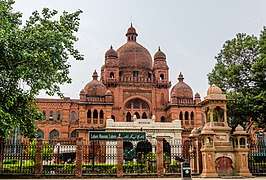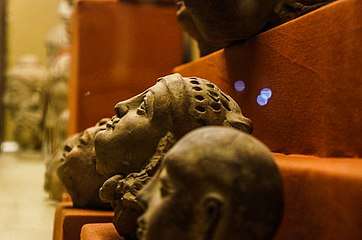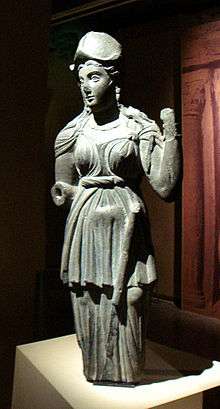Lahore Museum
The Lahore Museum (Punjabi: لاہور میوزیم; Urdu: عجائب گھر لاہور; “Lahore Wonder House”), is a museum located in Lahore, Pakistan. Founded in 1865 at a smaller location and opened in 1894 at its current location on 'The Mall' in Lahore during the British colonial period, Lahore Museum is Pakistan’s most visited and famous museums and remains one of the major museums in South Asia.[1]
عجائب گھر لاہور | |
 | |
 Entrance to the museum | |
Location within Lahore | |
| Established | 1865, later shifted to present site 1894 |
|---|---|
| Location | The Mall, Lahore Punjab Pakistan |
| Coordinates | 31.568226°N 74.308174°E |
| Type | Archaeology, art, heritage, modern history, religious |
| Collection size | Pre & Proto, Coins, Hindu Buddhist & Jain, Gandhara, Islamic, Manuscripts, Miniature Paintings, General Collection, Arms, Ethnological, Postage & Stamps, Arts & Crafts, Contemporary Paintings, Pakistan Movement Gallery |
| Visitors | 250,000 in 2005 |
| Website | Official website |
The museum, along with the Zamzama Gun located directly in front of the building, were made famous in the celebrated British novel Kim, written by Rudyard Kipling - whose father was one of the museum’s earliest curators. The museum is now also renowned for its extensive collection of Buddhist art from the ancient Indo-Greek and Gandhara kingdoms. It also has collections from the Mughal Empire, Sikh Empire and the British Empire in India.[2]
History


Lahore Museum was originally established in 1865-66 on the site of the current Tollinton Market - a hall built for the 1864 Punjab Exhibition.[3] The present building was constructed as a memorial of Golden Jubilee of Queen Victoria held in 1887, and financed through a special public fund raised on the occasion. The foundation stone of the new museum was laid on 3 February 1890 by Prince Albert Victor, Duke of Clarence and Queen Victoria’s grandson. On its completion in 1894, the entire museum collection was transferred to present building with its new name as Jubilee Museum.
The museum’s collection was later shifted in 1894 to its present location on The Mall, in Lahore’s British-era core.[1] The present building was designed by the well-known Lahori architect, Sir Ganga Ram.
Rudyard Kipling’s father, John Lockwood Kipling, was one of the museum’s first curators, and was succeeded by K. N. Sitaram. Over 250,000 visitors were registered in 2005.
Collections
The museum has a number of Greco-Buddhist sculptures, Mughal and Pahari paintings on display.[1] The collection contains important relics from the Indus Valley civilisation, Gandhara, and Graeco-Bactrian periods as well. The Fasting Buddha, dating from the Gandhara period, is one of the museums most prized and celebrated objects. The ceiling of the entrance hall features a large mural by renowned Pakistani artist Sadequain who originally made the mural in 1972 and 1973.[2][4]
The museum also contains fine specimens of Mughal and Sikh carved woodwork and has a large collection of paintings dating back to the British period. The collection also includes musical instruments, ancient jewellery, textiles, pottery, and armory, as well as some Tibetan and Nepalese work on display.[1][2]
Scope
The museum displays archaeological materials from pre-historic times (Mohenjo-Daro and Harappa civilisations) to the Hindu Shahi period.[2] It has one of the largest collections of archaeology, history, arts, fine arts, applied arts, ethnology, and craft objects in Pakistan. It also has an extensive collection of Hellenistic and Mughal coins.[1] There is also a photo gallery dedicated to the emergence of Pakistan as an independent state, the Pakistan Movement Gallery.[2]
Directors
| Museum Directors From First Day Forward: | Name of Directors | Position | Duration |
|---|---|---|---|
| Percy Brown | Curator | 1899 - 1912 | |
| Hugh Lionel Heath | Curator | 1912 - 1929 | |
| Rai Bahadur (S.N. Gupta) | Curator | 1929 - 1942 | |
| Mr. K. B. Molvi Zarar Hasan | Curator | 1942 - 1947 | |
| Malik Shams | Curator | 1947 - 1965 | |
| Syed Muhammad Taqi | Curator / Director | 1965 - 1974 | |
| Fred. Henry Andrews | Curator | 1893 - 1899 | |
| J.L. Kipling (C.I.E) | Curator | 1875 - 1893 | |
| Saifur Rehman Dar | Director | 1974 - 1993 | |
| F.M. Anjum Rehmani | Officiating Director | 1993 - 1995 | |
| Saifur Rehman Dar | Director | 1995 - 1998 | |
| F.M. Anjum Rehmani | Officiating Director | 1998 - 2001 | |
| Mansoor Sohail | Director Additional Charge | 2000 - 2001 | |
| Liaquat Ali Khan Niazi | Director | 2001 - 2004 | |
| Syed Gulzar Mashhadi | Director | 2004 - 2005 | |
| Naheed Rizvi | Director | 2005 - 2008 | |
| Asghar Nadeem Syed | Director | 2008 - 2009 | |
| Kamran Afzal Cheema | Director | 2009 - 2009 | |
| M.Siddique Sheikh | Director | 2009 - 2010 | |
| Humera Alam | Director | 2010 - 2012 | |
| Sumaira Samad | Director | 2012 - 2016 | |
| Himayun Mazhar | Director | Current |
Guidebooks
Masterpieces of Lahore Museum is a non-fiction book by Anjum Rehmani[5][6] published on 16 April 1999. UNESCO sponsor for the publication of this book[7][8]. The book cover history of Lahore Museum, Islamic Arts and Crafts, Hindu Jain and Buddhist Arts.[2][9][4] second edition of the book was published on 12 July 2006 and digitized on 8 December 2009[6][10]. Latter book revised version launched on 20 August 2019 as a Kindle Edition on Amazon Kindle and Umair Ahmad second author of this edition.[11]
Popular culture
- Rudyard Kipling's novel, Kim (pub. 1901), was set in the vicinity of the old/original Lahore Museum and the Mall areas.
Further reading
- Shaila Bhatti (2012), Translating museums: a counterhistory of South Asian museology, Walnut Creek, Calif: Left Coast Press, ISBN 9781611321449
- Whitehead, Richard Bertram (1914). Catalogue of Coins in the Panjab Museum, Lahore; Indo-Greek Coins : Volume 1. The Panjab Government at The Clarendon Press, Oxford.
- Whitehead, Richard Bertram (1914). Catalogue of Coins in the Panjab Museum, Lahore; Coins of Mughal Emperors: Volume 2. The Panjab Government at The Clarendon Press, Oxford.
See also
References
- Lahore Museum on Encyclopedia Britannica website Retrieved 25 November 2019
- "AROUND TOWN: Lahore Museum". DAWN.COM (newspaper). 31 October 2008. Retrieved 25 November 2019.
- Which later became the Tollinton Market after the completion of the new/present museum building, see "Murray's Handbook of the Punjab", pub. 1883. Mention also made in Peter Hopkirk, "Quest for Kim", London, 1996, pp.46-47 ISBN 0-7195-5560-4
- Arshad Bhatti (18 September 2012). "Museum to conserve Sadequain's mural". The Nation (newspaper). Retrieved 25 November 2019.
- Rehmani, Anjum (1999). Masterpieces of Lahore Museum. Lahore Museum.
- Masterpieces of Lahore Museum. Lahore Museum ; in collaboration with. 2006.
- "Masterpieces of Lahore Museum - UNESCO Digital Library". unesdoc.unesco.org. Retrieved 2019-09-10.
- Masterpieces of Lahore Museum (PDF).
- Lahore Museum (Pakistan) (2006). Masterpieces of Lahore museum. Lahore; in collaboration with; Islamabad: Lahore Museum ; United Nations Educational, Scientific and Cultural Organization. OCLC 137232699.
- "The Lahore Museum". Google Arts & Culture. Retrieved 2019-09-10.
- "Masterpieces of Lahore Museum : Lahore Museum : 9789693519020". www.bookdepository.com. Retrieved 2019-09-10.
External links
| Wikimedia Commons has media related to Lahore Museum. |


